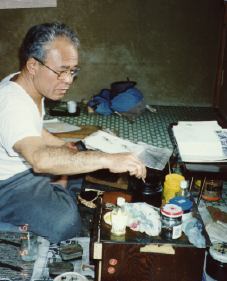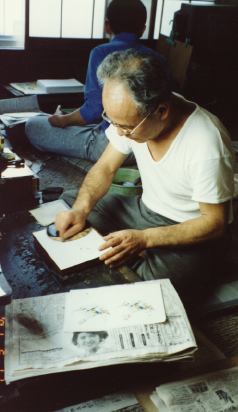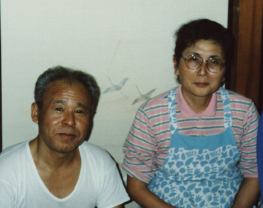Visit to ... Matsuzaki-san, the printer
Mr. Keizaburo Matsuzaki
The sound is what first catches your attention as you are climbing the narrow stairs to the workroom. A vigorous swirling, brushing sound (is somebody cleaning his shoes?) .... a slight rustle of paper .... a pause, and then another vigorous sound, this time a scratchy kind of rubbing .... another pause, another rustle of paper. What are these people doing? Of course, they are making woodblock prints - rubbing brushes over woodblocks, and barens over sheets of paper, the sequence repeated anew every few seconds as they work their way down the stacks of paper. Master printer Mr. Keizaburo Matsuzaki and his son Hiroshige are at work in their home in Tokyo's shitamachi district.
 On this particular visit, one of many I have made
to this room, the windows are closed to keep out the winter cold,
muting the traffic noise and leaving the soft sounds of the
printmaking work clearly audible. They are as familiar to
Matsuzaki-san as his own heartbeat and breathing, for he has been
hearing them now for 39 years, ever since taking his place at an
apprentice's bench at 15.
On this particular visit, one of many I have made
to this room, the windows are closed to keep out the winter cold,
muting the traffic noise and leaving the soft sounds of the
printmaking work clearly audible. They are as familiar to
Matsuzaki-san as his own heartbeat and breathing, for he has been
hearing them now for 39 years, ever since taking his place at an
apprentice's bench at 15.
Every time I watch him work, I am struck by the grace and ease with which he handles his tools. The baren seems to be an outgrowth of his massive hand, and when he reaches for the brush his eyes do not even bother to follow the movement, for after 10,000,000 repetitions he has no need to 'look' at what he is doing. He sits crosslegged at the low printing bench, and as his baren presses the paper onto the wood, the strength flows visibly in a circular path up his body, through his shoulders, down his arms, and out into the work. This energy remains visible in the print itself when it is peeled off the wood - with colours rich and deep - a permanent expression of the vitality that created it. Watching him at work, I think I begin to understand what ballet is all about ....
Right from the very beginning of my relationship with Matsuzaki-san, he has been as open, warm and friendly as anyone could possibly be. With some craftsmen that I have visited, a wall of 'reserve' has stood between us, blocking real communication, but in this room I have been made to feel like a partner rather than a guest. Each time I show him my latest printing efforts, he is willing to move beyond ritual politeness and offer me constructive help on improving my work. On one occasion he had me sit at his bench and show him with his tools what I was trying to do. Never had I ever felt so inept. My awkward movements, feeble attempts to make smooth colour, wasted energy - I tried to accomplish with brute force what he achieved with a wave of the hand. He laughed, demonstrated yet again, and offered more words of encouragement. How I envy Hiroshige - his chance to sit and work in this room, to drink in the movements, the rhythm of the work, the sounds ....
In the heyday of Ukiyo-e printmaking, men like Matsuzaki-san were common. Hundreds of printers lived in these streets, turning out stack after stack of the beautiful prints that now grace museums around the world. The highly critical eyes of the public, the demands of the publishers, and the ever increasing technical challenges put forward by the designers, all combined to push these men to ever higher standards of achievement. They were, and remain now, fiercely proud of their abilities. All their skills and resources were called for with each job.
 Such challenges are rare now. When I reach the
top of the stairs and poke my head around the corner, I know what I
will see on his printing bench - a stack of 3,000 tiny sheets of
paper to be printed with snow falling on a temple roof - Christmas
cards for next year. He makes no complaint about the work, simple
though it may seem, and gives it the same attention that he would
give a famous masterwork. He is a printer, and his job is to print. I
am the one who feels frustrated to see this. I want to run into the
streets and tell everybody what is happening here; that men such as
Matsuzaki-san are sitting in their rooms - waiting. Waiting for
society to realize what a treasure they have here; waiting for the
artists and publishers to knock at the door with new, challenging
designs to be printed; and waiting for the young generation to come,
to watch, and to listen ....
Such challenges are rare now. When I reach the
top of the stairs and poke my head around the corner, I know what I
will see on his printing bench - a stack of 3,000 tiny sheets of
paper to be printed with snow falling on a temple roof - Christmas
cards for next year. He makes no complaint about the work, simple
though it may seem, and gives it the same attention that he would
give a famous masterwork. He is a printer, and his job is to print. I
am the one who feels frustrated to see this. I want to run into the
streets and tell everybody what is happening here; that men such as
Matsuzaki-san are sitting in their rooms - waiting. Waiting for
society to realize what a treasure they have here; waiting for the
artists and publishers to knock at the door with new, challenging
designs to be printed; and waiting for the young generation to come,
to watch, and to listen ....
And this of course is how I offer my thanks to Matsuzaki-san for the time and energy he expends on my behalf. I get better. Bit by bit, slowly but surely, I get better. How much of his skill I will eventually absorb remains to be seen, but when my work is going badly and the frustration builds, I stop for a moment and try to picture him sitting there at his scarred and battered old workbench. I try and visualize the energy flowing down through his arms and out into the paper. I try .... I try ....
Matsuzaki-san, to your willingness to help me, I owe everything. The words 'thank you very much' do not even come close.


